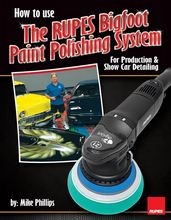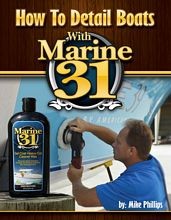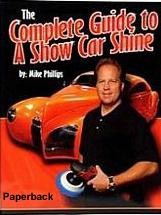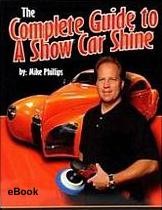Tips & Techniques for using a Spray Detailer to Remove Light Dust, Fingerprints and Smudges
Spray Detailers are for removing,
- Light dust
- Fingerprints
- Smudges
- And most can also be used as a clay lubricant (Read Manufactures Recommendations first)
Spray detailers are wonderful, time-saving products if used correctly on the correct condition of finish. They enable you to restore that "Just Detailed" look quickly and easily without having to wash and wax your car.
The key is evaluating the condition of your car`s paint and making the right judgment as to whether it`s safe to use a spray detailer or if it would be more intelligent to clean your car using a normal car wash process with a free flowing water source or a Rinseless Wash if you`re not in an area where you can perform a normal car wash.
The most common question I see posted on a forum or asked in a detailing class, or more accurately, the most common concern presented in a class or on the forum goes something like this,
How dirty can a car be and you can still safely use a spray detailer to wipe
surface dirt off the car without inflicting swirls and scratches in the process?
The answer is what I typed in the first part of this article and over the years I find myself typing this answer out over and over again because for some reason it either doesn`t sink in, or a segment of the car detailing population doesn`t like the answer.
So here it is again,
Spray Detailers are for removing,
Spray Detailers are NOT for removing caked on mud after you`ve been 4-wheeling in the mud bogs.
- Light dust
- Fingerprints
- Smudges
So how dirty can a car be?
The car can have light dust and then if you use a premium quality spray detailer, a premium quality microfiber polishing towel and good technique, then you can wipe the surface clean and not instill any swirls and scratches.
The definition of light dust
Here`s what light dust means... if you walk over to the hood of your car and you can see visible light dust, and with a strong breath blow over the hood and see the light dust move, this is light dust.
Light dust is just that, it`s a light accumulation of airborne dust and contaminants that have landed primarily on horizontal surfaces and have not in any way bonded to the paint.
Once light dust bonds to the paint it is no longer light dust but is in fact a film of dust or a film of dirt.
For example, if you wash and dry your car on Monday morning and the car sits outside exposed to the elements all day, (dry weather, as in it`s not raining or snowing), and by that Monday night you can see an accumulation of light dust on the surface, this is light dust.
Now if you leave your car parked outside overnight and dew forms on the exterior panels, the light dust will mix with the dew moisture and begins to form a film that will no longer simply blow off with air or dust-off using a tool like a California Duster. At least some portion of the previously un-bonded light dust has now become a bonded film.
If this pattern repeats for a few days, a week or a few weeks, that is each day dust settles on the car, the dust mixes with dew moisture over night, then the daytime dust will become a dirt film on the paint.
Again, spray detailers can be used safely to remove light dust. The key word here is safely.
Quote:
Question: Can spray detailers be used to remove a dirt film that has built up onto the paint?
Answer: Yes.
Question: Can spray detailers be used to safely remove a dirt film that has built up onto the paint?
Answer: What`s your definition of safely.
If by safely you mean that there is ZERO chance of inflicting swirls and scratches into the paint and you`re going to inspect and measure under the most grueling of light conditions then I would never publicly state it could be done safely and would never recommend it for this person, (this person = the person with the dirt film on the paint), in this application, especially if the car in question has a clear coated black or dark colored finish.
That`s because once dust and dirt form into a film onto a scratch-sensitive coating like your car`s clear coat finish, you`re going to have to rub a little in order to completely loosen this film and remove it and that`s not what most people would consider safe if the definition of safe means to not inflict any swirls or scratches.
Once your car`s paint has a film of dust built-up on the surface, you can use a spray detailer to clean your car but you`ve passed the limits and expectations of what a spray detailer is formulated to do safely. It will still clean and remove the dirt film, and you can be as careful as you like, but your expectations should be grounded in reality.
Once your car`s finish has more than light dust accumulated on the surface, then it`s time to consider using a normal car wash or a Rinseless Wash to remove the dirt if your goal is to maintain a swirl and scratch-free surface.
It could be that you could use a spray detailer on a car with worse than light dust on the paint and work completely safe and cause no marring of any type, but that will have to be your decision and you`ll need to access the risk involved and weigh it against your expectations for the quality of finish you expect to see on your car.
In the real world, if you`re car is not a garage queen, that is your car is a daily driver and while it has a very nice finish, you understand that through normal wear-n-tear that fine swirls are almost unavoidable when it comes to clear coat finishes that are exposed to the elements 24 hours a day and 7 days a week... if you understand this, then spray detailers are great for removing light dust and even light dust that`s accumulated over a few days.
It`s just a matter of matching your expectations with reality because reality is that clear coat paints are scratch-sensitive, this means while they tend to be harder than traditional single stage paints, like the paint that originally came on a 1965 Mustang, they can still scratch very easily and because there`s a colored basecoat of paint under the clear layer, this basecoat layer of paint acts to magnify any swirls or scratches in the top layer of clear paint and this makes it all too easy for your eyes to see, especially on a sunny day or under bright lights.
Spray detailers are great!
I love using them on my cars in-between a normal wash job and a regular coat of wax; but I fully understand what a spray detailer is formulated for and capable of doing and what is an unreal expectation.
Let`s talk about spray detailers...
How a spray detailer works
A quality spray detailer is supposed to lubricate, even HYPER lubricate the surface to help prevent scratching. A quality spray detailer will encapsulate dirt and dust particulates to help prevent scratching the paint during wipe-off. Most spray detailers also smell very nice and that always makes cleaning your car more enjoyable.
Tools Needed
- A premium quality spray detailer
- A collection of premium quality microfiber polishing cloths, each folded 4-ways.
Note: Folding your microfiber polishing cloths 4-ways will,
- Give you 8 sides of clean microfiber cloth to wipe with.
- Help spread out the pressure from you hand
How to use a spray detailer
- First mist the spray detailer over a small section of a panel.
- Next spread the spray detailer around gently with one side of a microfiber polishing cloth (folded 4-ways).
Before moving onto a new section, re-fold your microfiber polishing towel to expose a clean, dry side.
- Then quickly turn to the dry side and gently remove the spray detailer and buff the paint in this section to a dry, high shine. You are now finished with this section.
When starting a new section, remember to overlap a little into the previous section.
After you’ve used all 8 sides of a single microfiber polishing towel, switch to a fresh, clean microfiber polishing towel.
Two things you can do to help a spray detailer do its job better...
1. Use PLENTY of premium quality microfiber polishing towels
Don`t try to wipe your entire car down using one or two towels if the goal is to maintain a flawless finish.
How many microfiber polishing towels do you need?
10 to 12 Microfibers for an average size car. This is not a hard rule but an average based upon the pictures showing how I sliced-up the 1966 Mustang below.
If you want to take wiping a car down with a spray detailer to the extreme, then you fold a microfiber 4-ways and this give you 8 clean wiping sides. Do one wiping process one time with one side and then turn or fold to a new side. The more careful you want to be, the smaller you should make the section you wipe.
Assuming you fold to a fresh, clean, dry side of a folded microfiber for each new section, then working small sections will mean only removing small portions of dust which will be gathered onto the working face of the folded microfiber. The larger the section, the more potential dust you will remove and transfer to the working face of the folded microfiber.
Smaller sections = you`ll need more microfiber polishing towels.
Larger sections = you`ll need less microfiber polishing towels.
Small Vehicles = you`ll need less microfiber polishing towels.
Large Vehicles = you`ll need more microfiber polishing towels.
Personal comment
I worked in a Class 9000 Clean Room and we used a very strict protocol for wiping down surfaces with clean room wipes. The protocol was to wipe a surface with one side of a wipe one time, turn wipe over and make one new dedicated wipe and then dispose of the wipe. If there is more surface area to be cleaned, you get a new wipe. For wiping down a table or a large manufacturing tool, some as large as a small room, this took a lot of time and used a lot of wipes. The goal was somewhat the same as it is for removing dust off the car and that was to remove the dust, not spread it around. By only wiping with a single working face of a clean room wipe one time, that helped to insure any dust gathered off the surface was not merely transferred to a new section of the item being wiped by either turning to a clean side or disposing of the wipe.
2. Use good technique
Always fold your microfiber polishing towels 4-ways, this will give you 8 wiping sides and this will help to spread out the pressure form your hand. Wipe carefully, not like a Wild Man. Start at the top and work your way down. Horizontal surfaces will accumulate dirt, dust and airborne contaminants more than vertical surfaces. The lower portions of a vertical surface will accumulate more dirt and road grim than the upper portions of a vertical surface.
Results 16 to 18 of 18
Threaded View
-
02-01-2010, 02:41 PM #1
Tips & Techniques for using a Spray Detailer to Remove Light Dust, Fingerprints and Smudges
Mike Phillips
Host - Competition Ready on Velocity Channel
Director of Training Autogeek & Marine 31
Competition Ready Facebook Page
Mike Phillips Facebook Page
Twitter
Instagram
Click on a book to get your own copy.







Thread Information
Users Browsing this Thread
There are currently 1 users browsing this thread. (0 members and 1 guests)
Similar Threads
-
Holy Dust batman! QD spray that won`t attract dust?
By imported_BluHeaven in forum Car Detailing Product DiscussionReplies: 7Last Post: 04-06-2013, 06:20 AM -
Going to detail my first interior...any tips/suggestions/techniques?
By jnick in forum Car DetailingReplies: 9Last Post: 10-28-2007, 07:04 PM -
Does using a Quick Spray Detailer Remove Wax?
By mrjwhit in forum Car DetailingReplies: 2Last Post: 01-01-1970, 12:00 AM






 Reply With Quote
Reply With Quote
Bookmarks